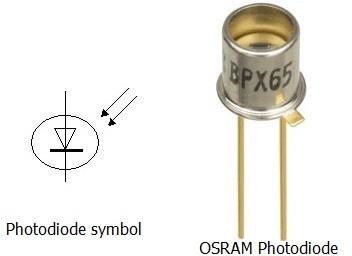Maintenance Center
FAQ - Photodiode vs PMT
Difference between Photodiode and Photomultiplier | Photodiode Vs Photomultiplier
Photodiode

It consists of a normal p-n junction housed in a small enclosure which a transparent window through which light can fall inside. Figure-1 depicts photodiode from OSRAM and symbol of photodiode. Photodiode is basically a type of photodetector capable of converting light into either current or voltage.
A photo diode is operated in reverse bias in which leakage current increases in proportion to the amount of light falling on the junction. This is result of light energy which breaks the bonds in the crystal lattice of the semiconductor producing electrons and holes. This effect is similar to photo voltaic cell.
- Photodiodes have high quantum efficiency and are compact in size.
- They are insensitive to magnetic field.
- Available as conventional photodiode and avalanche photodiode.
- Conventional photodiode does not have internal amplification.
Photomultiplier tube
- PMTs (Photomultiplier Tubes) are used for light detection of very weak signals.
- It is photo-emissive device in which absorption of photon results in emission of electron.
- It is one of the class of vacuum tubes also known as vacuum phototube.
- It is visible range photon sensor.
- Earlier PMTs are of larger size having glass vacuum envelopes, now they are available in smaller sizes.
- Now-a-days PMTs are replaced by avalanche photodiodes, but still they are in use in variety of applications such as Raman spectrophotometry, Fluorescent molecular tagging applications and single photon counting luminescence.
The major difference between photodiode and photomultiplier tube.
->Photodiode convert one photon into one electron, while photomultiplier amplify electrons. Photomultiplier tube uses detector which changes photons into electrons so that they can be detected. Later photomultiplier tube uses dynodes to amplify the electrons.
Source: RF Wireless World (https://www.rfwireless-world.com/)
Depending on the models, Techcomp UV-VIS Spectrophotometers are using both PMT and photodiode as detectors.
|
For more product information, please visit
https://hk.techcomp.com.hk/EN/product/?MenuID=323
